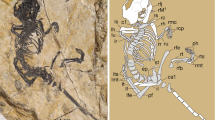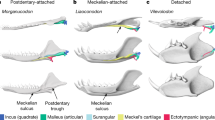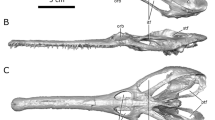Abstract
Auditory reception in elasmobranchs, teleosts and amphibians may be mediated by various inner-ear sensory epithelia1–3, including the basilar papilla, which seems to be the precursor of the cochlea in mammals. The origin of the basilar papilla remains a major unsolved problem for understanding the evolution of hearing in terrestrial vertebrates4–6. Study of living species indicates that the basilar papilla is a unique feature of tetrapods6,7, but palaeonto-logical data indicate that this epithelium as well as a middle ear, is already present in crossopterygian fish8–10. However, no basilar papilla has been found in the only living crossopterygian species, the coelacanth Latimeria chalumnae11. I have re-examined the inner ear of adult and embryonic Latimeria and find a membranous specialization which resembles in structure, position and innerva-tion pattern the basilar papilla of tetrapods, in particular amniotes. No epithelium comparable to the basilar papilla was found in lungfish. I suggest that the basilar papillae of Latimeria and tetrapods are homologous and evolved only once in their common ancestor.
This is a preview of subscription content, access via your institution
Access options
Subscribe to this journal
Receive 51 print issues and online access
$199.00 per year
only $3.90 per issue
Buy this article
- Purchase on Springer Link
- Instant access to full article PDF
Prices may be subject to local taxes which are calculated during checkout
Similar content being viewed by others
References
1. Tavolga, W. N., Popper, A. N. & Fay, R. R. Hearing and Sound Communication in Fishes (Springer, New York, 1981). 2. Lewis, E. R., Leverenz, E. L. & Bialek, W. S. The Vertebrate Inner Ear (CRC Press, Boca Raton, Florida, 1985). 3. Northcutt, R. G. in Comparative Studies of Hearing in Vertebrates (eds Popper, A. N. & Fay, R. R. 75–118 (Springer, New York, 1980). 4. Retzius, G. Das Gehororgan der Wirbeltiere (Samson & Walin, Stockholm, 1881). 5. Werner, C. F. Das Gehorgan der Wirbeltiere und des Menschen (Thieme, Leipzig, 1960). 6. Baird, I. L. in Handbook of Sensory Physiology, Vol. V/l, (eds Keidel, W. D. & Neff, W..D.) 159–212 (Springer, Berlin, 1974). 7. Lombard, R. E. & Bolt, J. Biol J. Linn. Soc. 11, 19–76 (1979). 8. Romer, A. S. Bull. Mus. comp. Zoo/. Harv. 82, 1 (1937). 9. Jarvik, E. Basic Structure and Evolution of Vertebrates (Academic, London, 1980). 10. Van Bergeijk, W. A. Am. Zool. 6, 371–377 (1966). 11. Millot, J. & Anthony, J. Anatomic de Latimeria chalumnae Vol. 2 (Centre National Recherche Scientifique, Paris, 1965). 12. Rosen, D. E., Forey, B. G., Gardiner, B. G. & Patterson, C. Bull. Am. Mus. nat. Hist. 167, 6163–275 (1981). 13. Burns, R. H. Anat. Anz. 43, 396–400 (1913). 14. Gauldie, R. W., Dunlop, D. & Tse, J. N.Z. Jl mar. Fresh. Res. 20, 81–92 (1986). 15. Bjerring, H. C. in Evolutionary Biology of Primitive Fishes (eds Gorbman, A., Dodd, J. M. & Olsson, R.) 31–57 (Plenum, New York, 1985). 16. Fritzsch, B., Nikundiwe, A. M. & Will, U. / comp. NeuroL 229, 451–468 (1984). 17. Kremers, J. W. P. M. & Nieuwenhuys, R. / comp. Neurol. 187, 613–638 (1979).
Author information
Authors and Affiliations
Rights and permissions
About this article
Cite this article
Fritzsch, B. Inner ear of the coelacanth fish Latimeria has tetrapod affinities. Nature 327, 153–154 (1987). https://doi.org/10.1038/327153a0
Received:
Accepted:
Issue Date:
DOI: https://doi.org/10.1038/327153a0
This article is cited by
-
Multilocus phylogenetic analysis with gene tree clustering
Annals of Operations Research (2019)
-
Comparative Auditory Neuroscience: Understanding the Evolution and Function of Ears
Journal of the Association for Research in Otolaryngology (2017)
-
Comparative and developmental patterns of amphibious auditory function in salamanders
Journal of Comparative Physiology A (2016)
-
Evolution of vertebrate mechanosensory hair cells and inner ears: toward identifying stimuli that select mutation driven altered morphologies
Journal of Comparative Physiology A (2014)
Comments
By submitting a comment you agree to abide by our Terms and Community Guidelines. If you find something abusive or that does not comply with our terms or guidelines please flag it as inappropriate.



